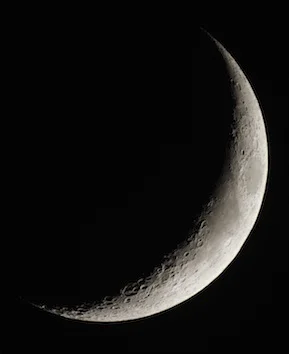A solar eclipse happens when the moon passes between the Earth and the sun.
Its shadow blots out the sun.
During a solar eclipse, it gets darker and darker outside as more and more of the Sun is covered by the moon's shadow.
During a total eclipse, the entire Sun is covered for a few minutes.
The temperature outside also drops.
Do not look directly at the sun during an eclipse: it can damage your eyes.
A solar eclipse happens at times when the moon is directly in between the Earth and Sun. Getty
About twice a year, at a time when there is a new moon, part of the moon's shadow falls on the Earth's surface and there is an eclipse of the sun seen in some places on Earth. Most of the time, the moon's shadow misses Earth at new moon because the moon's orbit is tilted at 5º to Earth's orbit around the sun.
The moon has no light of its own, but shines because sunlight is reflected off its surface. It orbits (circles around) the Earth, and each orbit takes twenty nine and a half days.
Phases of the moon
When we see the moon from Earth, its changing position as it orbits makes it look different. This is called the 'phases of the moon'. The phases are:
new moon
new crescent
first quarter
waxing gibbous,
full moon
waning gibbous
last quarter
old crescent...then back to new moon again
A new moon cannot actually be seen because the shining side of the moon is facing away from Earth, and the dark side is facing Earth. The new moon is close to the sun in the sky as we look at it from Earth, so it rises and sets at the same time.
© iStock
The moon's shadow has two parts:
Penumbra: a faint outer shadow
Umbra: a dark inner shadow
When just the Penumbra shadow touches Earth, it is a partial eclipse of the sun in that place. Only part of the sun is blocked. The part of the sun not eclipsed is very bright, and it is very harmful to the eyes to look at it without special filters.
When the Umbra shadow touches Earth, a total eclipse of the sun is seen in that part of the world. The time that the sun is completely blocked out in a total eclipse takes just a few minutes, but is a spectacular sight. Day becomes twilight as the black shadow of the moon completely blocks the sun, but a halo effect surrounds it, caused by the sun's corona.
The Path of Totality is the section of Earth that can see a total eclipse. This is in different parts of the world each time.
Did you know?
People in ancient Egypt, Asia and Greece worshipped the sun. They thought that an eclipse of the sun, when the moon passes in front of the sun and blocks the light, was the sun god showing anger.
Read more about solar eclipses:
http://encyclopedia.kids.net.au/page/so/Solar_eclipse
Watch a video of a solar eclipse
https://youtu.be/NV6fTZzKZQ8?si=kXR16hKh907TufGn
Explore educational games on eclipses at NeoK12



